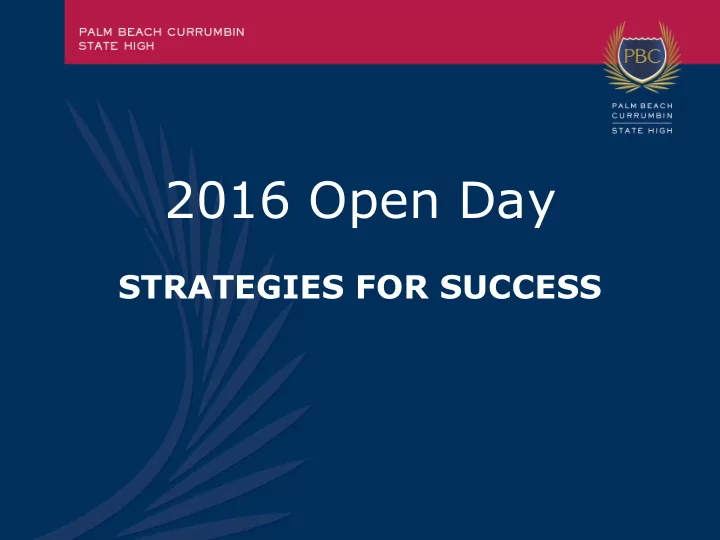

2016 Open Day STRATEGIES FOR SUCCESS
Foundation Support Strategies Sharon Hillcoat Head of Department – Middle School
Strategies for Success • Study skills • Reading strategies • Stretching your child academically
Exposure to material x Different settings = Greater recall
Homework can be a chance to: • Practise skills • Quiet reflection • Reading ‘around’ a topic • Research
OPTIMA Goals What grade is your child aiming for? • What do they need to do to get there? • Conversations about specific criteria and learning strategies
No homework written down? Try: Rewrite class notes • 20 minutes of exam study • Read a related article • Plan or draft an assignment • Practise spelling or paragraph writing •
Supporting Comprehension Rigour Lisa McGuire Dean of Teaching and Learning
COMPREHENSION AT PBC How can I support my child in reading and comprehension?
Question, Brainstorm, Reform What is comprehension?
Comprehension in the Middle School Reading to learn is an integral part of pedagogy within PBC and has been embedded within and across the curriculum to best allow students to attain their potential in this sphere.
Comprehension is explicitly taught to enhance student outcomes across a range of KLAs and it is the teacher and student’s responsibility to engage with a variety of text types to develop complex understandings of the relevant content as well as demonstrating their understanding of the metacognitive processes involved.
EMBEDDED KEY COMPREHENSION STRATEGIES
Tactical Teaching of Reading (TTR) Getting students to engage with TTR activities while they are reading.
The metacognitive process and recognition of tactics is vital – students should know why they are using a particular strategy and be able to translate this application to any reading exercise.
Read the question, read the text then answer the question (RRA): Encouraging students to read the questions first so they can annotate and highlight to identify answers.
Time Constraints Make the kids ‘have a crack’ in a short time frame – pace is an important part of rigour. This should not detract from the explanation and deconstruction afterwards
Elimination With multiple choice questions eliminate the obviously incorrect responses to at least have a 50/50 chance of getting the answer correct.
Decoding Difficult and Challenging Words Showing kids how you break down difficult vocabulary. E.g. 2R4C
2R R eread the sentence that includes the difficult word R ead on past the difficult word 4C C onsider the context ‘ C hunk’ the word into meaningful parts C ompare the word with others they know C heck a reference such as a glossary, a dictionary or a thesaurus, or check with a peer or teacher
Annotation “Inking their thinking” – students should be writing on their question sheets and texts – this is a visual representation of their cognitive processes. When this becomes purposeful it allows for faster processing of information.
Reflection • How can I reinforce these strategies when helping with assessment and homework? • Utilising the metalanguage at home can reinforce the relevance of the strategy.
Reflection • I know most of this seems like common sense but it is amazing the results we can achieve if we standardised the metalanguage within and around comprehension. • Working together we can enhance outcomes for all students.
• Lead a quality literacy program • Track and celebrate student success • Coach and develop teachers skills
Literacy Program This initiative is based on research and is incorporated into the first 20 minutes of each English lesson across Years 7, 8 and 9.
How parents can help Lesson 1 Lesson 2 Lesson 3 Lesson 4 Spelling Explicit teaching of Explicit reminder Spelling post-test • • • • pre-test the spelling pattern of the spelling 5 Multiple Choice • Exposure to Language pattern. questions re the • • the reading conventions (LC) - Language spelling pattern • text E.g. abstract vs conventions and the LC concrete nouns activity Homework: Reading log – 40 minutes/ week • Fortnightly writing task – response to stimulus • OTHER HOMEWORK : 20 minutes per subject studied that day •
Supporting High Academic Achievement Ty Russell Teacher
Supporting High Academic Achievers …and supporting all students to achieve high, academically.
Two Groups of Students… A. Those who already achieve at a high standard B. Those who are capable of high achievement levels but are not performing within their capability
A. Those who already achieve at a high standard: • Stress • Perfectionism • Life Balance
B. Those students who are capable of high achievement levels but are not performing to their capability.
How can you help the underachiever?
How Can We Help at PBC? Homework club • Study timetables • Year Co-ordinator • Guidance Officer •
How can you help your bright young person? Highly developed aesthetics Art Exhibitions • Museum visits • Plays • Films • Family Events
Recommend
More recommend